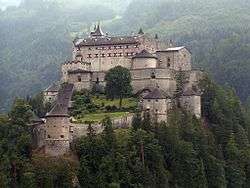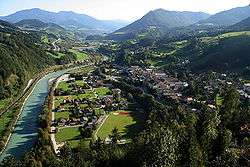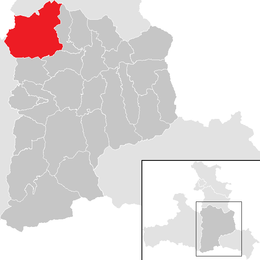Werfen
| Werfen | ||
|---|---|---|
|
View from Burg Hohenwerfen | ||
| ||
 Werfen Location within Austria | ||
Werfen in Pongau district
| ||
| Coordinates: 47°28′30″N 13°11′20″E / 47.47500°N 13.18889°ECoordinates: 47°28′30″N 13°11′20″E / 47.47500°N 13.18889°E | ||
| Country | Austria | |
| State | Salzburg | |
| District | St. Johann im Pongau | |
| Government | ||
| • Mayor | Franz Meissl (SPÖ) | |
| Area | ||
| • Total | 154 km2 (59 sq mi) | |
| Elevation | 548 m (1,798 ft) | |
| Population (1 January 2016)[1] | ||
| • Total | 2,975 | |
| • Density | 19/km2 (50/sq mi) | |
| Time zone | CET (UTC+1) | |
| • Summer (DST) | CEST (UTC+2) | |
| Postal code | 5450 | |
| Area code | 06468 | |
| Vehicle registration | JO | |
| Website | Official website | |
Werfen is a market town in the St. Johann im Pongau District, in the Austrian state of Salzburg. The municipality comprises the cadstral communities (Katastralgemeinden) of Reitsam, Scharten, Sulzau and Wimm. It is mainly known for medieval Hohenwerfen Castle and the Eisriesenwelt ice cave, the largest in the world.
Geography
Werfen is located in the northwest of the historic Pongau region, on the southern rim of the Berchtesgaden Alps (east of Mt. Hochkönig) and the Tennengebirge. It is situated in the valley of the Salzach River, about 40 km (25 mi) south of the city of Salzburg. The Salzburg-Tyrol Railway line (Giselabahn) and the Tauern Autobahn run parallel to the river.
History
The settlement, one of the oldest markets in the former Archbishopric of Salzburg, arose south of the Burg Hohenwerfen, erected from 1075 at the behest of the Archbishop Gebhard during the Investiture Controversy with Emperor Henry IV. As the seat of a local administrator, Werfen and the castle were heavily attacked during the German Peasants' War in 1525/26. It was also a centre of the expulsion of Protestant citizens under the rule of Archbishop Count Leopold Anton von Firmian in 1731. With the lands of the former archbishopric, Werfen finally fell to the Austrian Empire after the Vienna Congress in 1816.
The secluded Blühnbach Valley above the village of Tenneck is the site of the Baroque Blühnbach Castle, a former hunting lodge of Archbishop Wolf Dietrich Raitenau, which in 1908 was acquired by Archduke Franz Ferdinand of Austria. After the archduke's assassination, the Habsburg-Lorraine dynasty sold the castle to the German Krupp industrial magnates, it is today a private property of Frederick R. Koch.
A small portion of a picnic scene from The Sound of Music was filmed on a hillside of the village of Werfen. Julie Andrews and crew filmed the opening shots of the "Do-Re-Mi" sequence with the Burg Hohenwerfen in the background.[2] Hohenwerfen was also the location for some filming of Where Eagles Dare.
Politics
Seats in the municipal council (Gemeinderat) as of 2009 elections:
- Social Democratic Party of Austria (SPÖ): 9
- Austrian People's Party (ÖVP): 6
- Freedom Party of Austria (FPÖ): 4
Gallery
- Main square
 Eisriesenwelt Cave
Eisriesenwelt Cave
 View from above
View from above
References
- ↑ Statistik Austria - Bevölkerung zu Jahresbeginn 2002-2016 nach Gemeinden (Gebietsstand 1.1.2016) for Werfen.
- ↑ See "The Sound of Music Filming Locations" at The Worldwide Guide to Movie Locations. http://www.movie-locations.com/intromovies/soundmusic.html. Accessed 27 March 2007.
External links
| Wikimedia Commons has media related to Werfen. |
- (German) Werfen official website
- (German) Werfen info website


